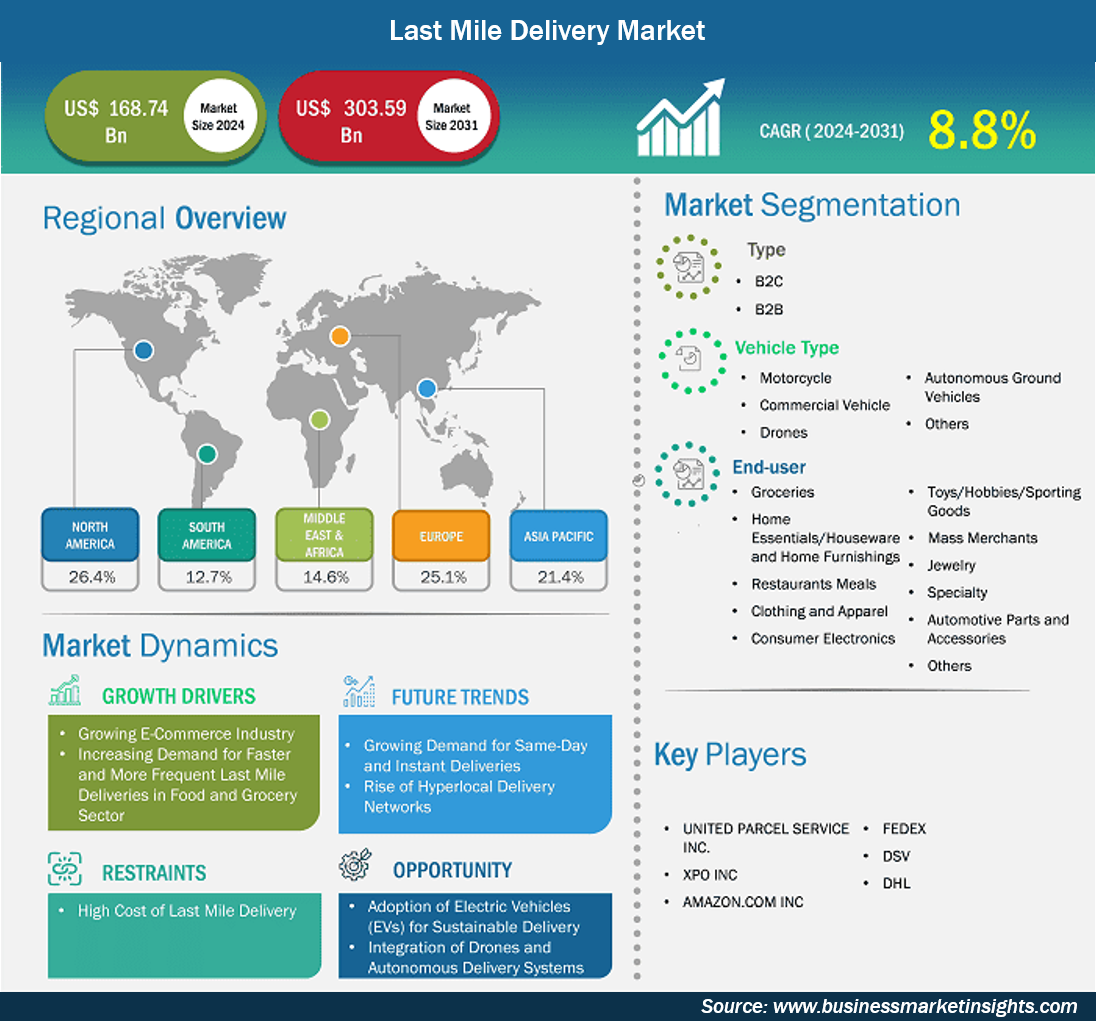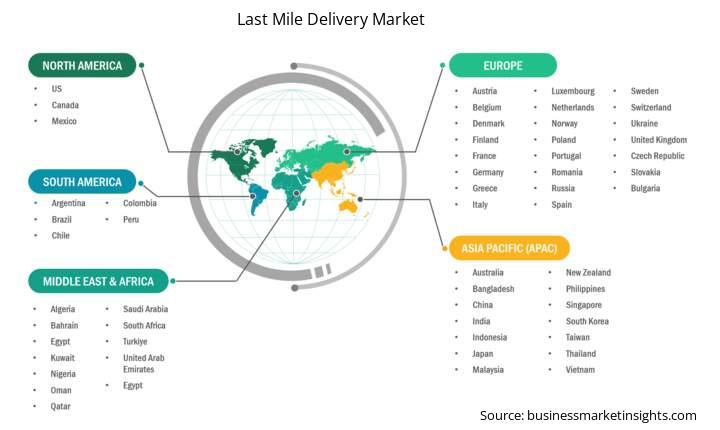Last Mile Delivery Market Report (2021–2031) by Scope, Segmentation, Dynamics, and Competitive Analysis
No. of Pages: 150 | Report Code: BMIRE00031132 | Category: Automotive and Transportation
No. of Pages: 150 | Report Code: BMIRE00031132 | Category: Automotive and Transportation
The Last Mile Delivery Market size is expected to reach US$ 3,03,593.58 million by 2031 from US$ 1,68,739.40 million in 2024. The market is estimated to record a CAGR of 8.8% from 2023 to 2031.
The last mile delivery refers to the final step in the supply chain, where products are transported from a distribution center to the end customer’s location. It plays a vital role in the logistics and e-commerce industries, where the consumer’s expectation for fast, reliable, and cost-effective delivery has transformed the way goods are delivered to homes, businesses, and other destinations. The growth of e-commerce, the increasing demand for faster deliveries, and technological advancements are a few factors fueling the need for last mile delivery, a critical focus for logistics companies worldwide.
A few of the critical factors supporting the growth of the last mile delivery market are mentioned below:
Customer Expectations: Faster delivery times, free shipping, and visibility into the delivery process are increasingly expected by consumers, especially with the growth of e-commerce giants such as Amazon and Alibaba.
Logistics Costs: Last mile delivery often accounts for a significant portion of total logistics costs due to the complexity of navigating urban areas, maintaining fleets, and managing multiple delivery points.
Technological Innovations: Advancements in delivery technologies such as autonomous vehicles, drones, and artificial intelligence (AI) are reshaping the landscape of last mile logistics.

Key segments that contributed to the derivation of the Last Mile Delivery market analysis are type and application.
Growing E-Commerce Industry
The e-commerce industry is expanding rapidly across the globe. As consumers increasingly incline toward online shopping for its convenience and variety, retailers are challenged to deliver products swiftly and efficiently. This surge in demand has led to significant investments in logistics technologies, including route optimizations, automated warehouses, and real-time tracking systems to enhance delivery speed and reliability. The rise of same-day and next-day delivery options has become a competitive differentiator for e-commerce businesses. As online shopping habits continue to evolve, the need for innovative last mile solutions increases. This rise prompts logistics providers to adapt and expand their capabilities to meet consumer expectations.
As per the International Trade Administration, B2B e-commerce sales have been steadily increasing for the last decade from 2012 to 2022, with the B2B e-commerce market expected to reach US$ 36 trillion by 2026. Industries such as advanced manufacturing, energy, healthcare, and professional business services are anticipated to drive B2B e-commerce sales during the analyzed timeframe. Leading sectors in B2B e-commerce sales include consumer electronics, fashion, furniture, toys, pharmaceutical, and food. Thus, the growing e-commerce industry across the globe boosts the last mile delivery market growth.
Integration of Drones and Autonomous Delivery Systems
With the potential to reduce delivery time, improve efficiency, and cut down labor costs, these technologies are poised to revolutionize the industry. Drones can bypass traffic congestion in urban areas and deliver packages directly to customers’ doorsteps faster than traditional delivery vehicles. Additionally, autonomous delivery vehicles (AVs) can operate continuously, shortening delivery windows and improving efficiency.
Autonomous vehicles and drones can solve various challenges imposed by traditional delivery methods, such as urban congestion, traffic jams, and lack of parking spaces in densely populated cities. AI-driven route optimization and autonomous navigation help navigate around roadblocks and deliver goods more quickly. Moreover, by replacing human drivers with autonomous systems, delivery companies can reduce labor costs, especially in the face of growing labor shortages in the logistics industry. Drones eliminate the need for ground-based delivery personnel, further cutting costs and making the process more efficient. Integration of drones and autonomous delivery systems is anticipated to disrupt the traditional last mile delivery models and introduce new operational paradigms. For example, companies such as Amazon, Wing (Alphabet), and UPS are already testing drones, while Tesla and other companies are working on autonomous vehicles for deliveries. Regulatory challenges remain, but once adopted, these technologies are expected to revolutionize deliveries and have the potential to redefine customer experience in the last mile process.
Based on type, the global last mile delivery market is bifurcated into B2C and B2B. The B2C segment registered a larger market share in 2024 and is expected to dominate during the forecast period. Last mile delivery of the Business to Customer (B2C) focuses on delivering packages and items from close transportation hubs to end clients. On the other hand, Business-to-business (B2B) last-mile delivery sends products from a warehouse or fulfillment center to the brick-and-mortar retailers or enterprises that order them.
Based on vehicle type, the global last mile delivery market is segmented into motorcycles, commercial vehicles, drones, autonomous vehicles, and others. The commercial vehicle segment dominated the market for vehicle type in 2024 owing to the increasing adoption of last mile delivery services. Furthermore, the drone segment is expected to register the highest growth rate during the forecast period. Several companies are electrifying their fleets to reduce carbon emissions. In October 2023, Amazon quadrupled its fleet of custom-designed Rivian electric delivery vehicles (EDVs) to 10,000 cars, making last-mile deliveries in 1,800 locations in the US. The adoption of drone deliveries is increasing rapidly. The US is at the forefront of drone adoption for last mile delivery. E-commerce giants and logistics giants in the US were the first companies worldwide to start drone deliveries.
Last Mile Delivery Market Report Highlights
Report Attribute
Details
Market size in 2024
US$ 1,68,739.40 Million
Market Size by 2031
US$ 3,03,593.58 Million
Global CAGR (2025 - 2031)
8.8%
Historical Data
2022-2023
Forecast period
2025-2031
Segments Covered
By Last Mile Delivery Market
By Type
By Vehicle Type
By End User
Regions and Countries Covered
North America
The "Last Mile Delivery Market Size and Forecast (2021–2031)" report provides a detailed analysis of the market covering below areas:
Last Mile Delivery Market Country and Regional Insights

The geographic scope of the Last Mile Delivery market report is divided into five regions: North America, Asia Pacific, Europe, Middle East & Africa, and South & Central America. The Last Mile Delivery market in Asia Pacific is expected to grow significantly during the forecast period.
North America is one of the largest and most advanced markets for last-mile delivery services, largely driven by the booming e-commerce sector, consumer demand for faster deliveries, and technological innovation. The United States and Canada are key contributors to the market growth, where major players such as Amazon, FedEx, UPS, and autonomous and electric vehicle (EV) startups are leading the transformation. The last-mile delivery market in North America is expected to grow at a significant pace, with innovations such as autonomous delivery drones, EVs, and advanced route optimization technologies playing a key role. However, the challenge of balancing cost and speed of delivery is anticipated to persist as consumer demand for instant gratification continues to rise. Europe has witnessed substantial growth in the last-mile delivery sector, driven by its highly developed logistics infrastructure, technological advancements, and e-commerce market. Key markets such as the United Kingdom, Germany, France, and the Netherlands are leading the way in terms of last-mile innovations and the integration of sustainable solutions. The last-mile delivery market in Europe is poised for steady growth, driven by advancements in sustainable technology, the growing e-commerce industry, and increased consumer demand for faster deliveries. The adoption of eco-friendly delivery methods and the continued development of urban logistics hubs are expected to play key roles in shaping regional market dynamics
Last Mile Delivery Market Research Report Guidance
The Last Mile Delivery market is evaluated by gathering qualitative and quantitative data post primary and secondary research, which includes important corporate publications, association data, and databases. A few of the key developments in the Last Mile Delivery market are:
The Last Mile Delivery Market is valued at US$ 1,68,739.40 Million in 2024, it is projected to reach US$ 3,03,593.58 Million by 2031.
As per our report Last Mile Delivery Market, the market size is valued at US$ 1,68,739.40 Million in 2024, projecting it to reach US$ 3,03,593.58 Million by 2031. This translates to a CAGR of approximately 8.8% during the forecast period.
The Last Mile Delivery Market report typically cover these key segments-
The historic period, base year, and forecast period can vary slightly depending on the specific market research report. However, for the Last Mile Delivery Market report:
The Last Mile Delivery Market is populated by several key players, each contributing to its growth and innovation. Some of the major players include:
The Last Mile Delivery Market report is valuable for diverse stakeholders, including:
Essentially, anyone involved in or considering involvement in the Last Mile Delivery Market value chain can benefit from the information contained in a comprehensive market report.